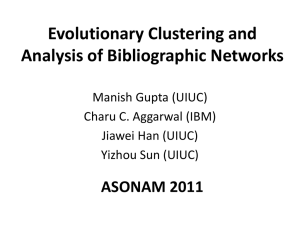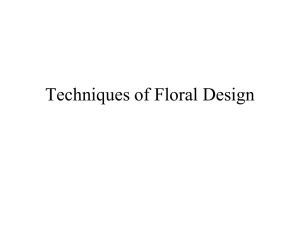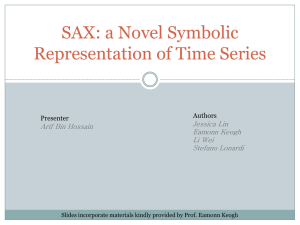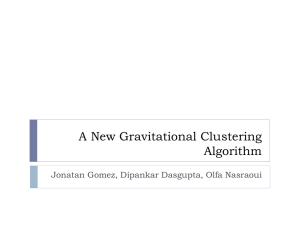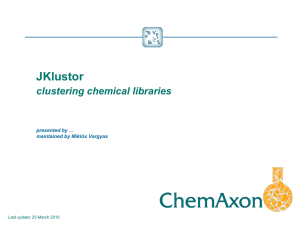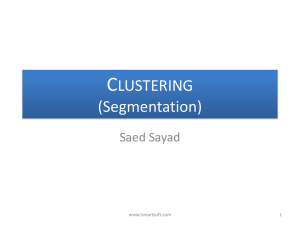*** 1
advertisement
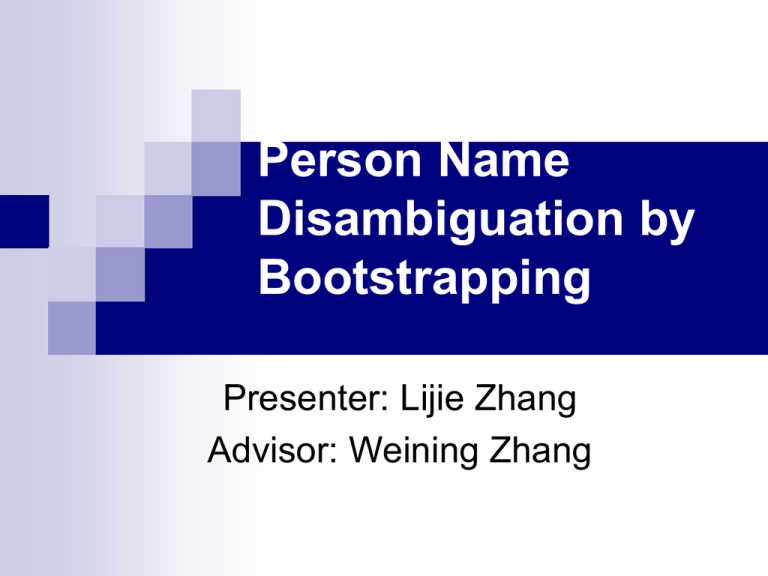
Person Name
Disambiguation by
Bootstrapping
Presenter: Lijie Zhang
Advisor: Weining Zhang
Outlines
Introduction
Motivation
Two-stage Clustering Algorithm
Experiments
People Name Disambiguation
Given a target name (query q ), search engine
returns a set of web pages P={d1, d2, …, dn }
Task: cluster web pages P such that each
cluster refers to a single person.
Example: People Name Disambiguation
People Name Disambiguation
A typical solution:
Extract a set of features from each document returned by search
engine
Cluster the documents based on some similarity metrics on sets
of features
Two types of features
Strong features such as named entities (NEs), compound key
words (CKWs), URLs
NE: Paul Allen, Microsoft (indicate the person Bill Gates)
CKW: chief software architect (a concept strongly related to Bill
Gates)
Very strong ability to distinguish between clusters.
Weak features: single words
People Name Disambiguation
Evaluation Metric: F measure
Treat
each cluster as if it were the result of a
query and each class as if it were the desired
set of documents for a query
For
class i and cluster j,
Recall(i, j)= nij/ni, Precision(i, j)=nij/nj
F(i, j) = (2 * Recall(i, j) * Precision(i, j)) /
((Precision(i, j) + Recall(i, j))
Motivation
Problem of current systems: Using only strong
features achieves high precision but low recall.
Proposed solution: two-stage clustering
algorithm by bootstrapping to improve the recall
value.
1st stage: strong features
2nd stage: weak features
Two-stage Clustering Algorithm
Input: one query string
Output: a set of clusters
1. Preprocessing documents returned by
search engine
2. First-stage clustering
3. Second-stage clustering
Preprocessing a Document
Covert HTML files to text files
Remove
HTML tags
Keep sentences
Extract text around query string
Using
a window size
Extract strong features (NEs, CKWs,
URLs)
Extract Strong Features
Use Stanford NER to identify NEs:
a
set of sets of names including names of persons,
organizations, and places
Compound Key Word (CKW) Features: a set of
CKWs
Extract compound words (CW): w1w2..wl
Score each CW:
Determine CKW based on a threshold of
scores.
Extract URLs from the original HTML files
exclude
URLs with high frequencies
Two-stage Clustering Algorithm
Input: one or more query strings
Output: a set of clusters
1. Preprocessing documents returned by
search engine
2.1st stage clustering
3. 2nd stage clustering
First stage clustering
1.
2.
Calculate the similarities between documents
based on these features
Use standard hierarchical agglomerative
clustering (HAC) algorithm for clustering
Document Similarities
Similarity for NE features and CKW
features
avoids too small denominator values in the
equation
Document Similarities
Similarity for URLs
Document Similarities
Similarity for NE:
Similarities for NE, CKW, and URL
First stage clustering
1.
2.
Calculate the similarities between documents
based on these features
Use standard hierarchical agglomerative
clustering (HAC) algorithm for clustering
HAC algorithm
Starts from one-in-one clustering, i.e. each
document is a cluster
Iteratively merge the most similar cluster
pairs, which similarity is above a threshold.
Cluster similarity:
Two-stage Clustering Algorithm
Input: one or more query strings
Output: a set of clusters
1. Preprocessing documents returned by
search engine
2.1st stage clustering
3. 2nd stage clustering
Second Stage Clustering
Goal: Cluster documents still in one-in-one clustering
after the first stage clustering
Idea of bootstrapping algorithm:
Given some seed instances, finds patterns useful to extract such
seed instances;
Use these patterns to harvest new instances, and form the
harvested new instances new patterns are induced.
Instances correspond to documents
Patterns correspond to weak features: 1-gram, 2-gram in
experiment
Second Stage Clustering
(0)
R d ,C
0
0
0
0
0
.
0
1
0
0
1
0
0
1
0
0
1
0
0
0
1
0
.
.
.
0
0
0
0
0
0
0
0
.
1
Experiments Setup
Dataset: WePS-2
30 names, each has 150 pages
The same page can refer to two or more entities;
Evaluation Metrics [5]
Multiplicity precision and recall between document e and e’
C(e) is predicted cluster of e, L(e) is the cluster assigned to e by
the gold standard
Example of Evaluation Metrics
L(1)={A,B} L(2)={A,B}
C(1)={ct1, ct2}
C(2)={ct1, ct2}
L(1)={A,B} L(2)={A,B}
C(1)={ct1} C(2)={ct1,
ct2}
L(1)={A,B} L(2)={A,B}
C(1)={ct1,ct2,ct3}
C(2)={ct1, ct2,ct3}
Experiments Setup
Evaluation Metrics
Extended
B-Cubed precision (BEP) and recall (BER)
Experiments Setup
Baselines:
First
stage clustering: all-in-one, one-in-one,
combined baseline (each doc belongs to one
cluster from all-in-one and one from one-inone).
Second stage clustering: TOPIC algorithm,
CKW algorithm
Experiments Results
References
[1] A. Bagga and B. Baldwin. Entity-based cross-document coreferencing using the
vector space model. In Proceedings of COLING-ACL 1998, pages 79–85, 1998.
[2] C. Niu, W. Li, and R. K. Srihari. Weakly supervised learning for cross-document
person name disambiguation supported by information extraction. In Proceedings of
42nd Annual Meeting of the Association for Computational Linguistics (ACL-2004),
pages 598–605, 2004.
[3] X. Liu, Y. Gong, W. Xu, and S. Zhu. Document clustering with cluster refinement and
model selection capabilities. In Proceedings of the 25th annual international ACM
SIGIR conference on Research and development in information retrieval, pages 191–
198, 2002.
[4] X. Wan, M. L. J. Gao, and B. Ding. Person resolution in person search results:
WebHawk. In Proceedings of CIKM2005, pages 163–170, 2005.
[5] E. Amigo, J. Gonzalo, J. Artiles, and F. Verdejo. A comparison of extrinsic clustering
evaluation metrics based on formal constraints. Information Retrieval, 12(4), 2009.
[6] Minoru Yoshida, Masaki Ikeda, Shingo Ono, Issei Sato, Hiroshi Nakagawa. Person
Name Disambiguation by Bootstrapping. In Proceedings of SIGIR, 2010.
